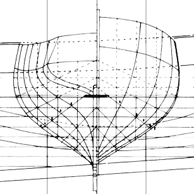Yacht design
boat design
Yacht design or naval design is a complex and composite design sector that deals generally with boats. Specifically, the reference to yachting refers to boats to recreational and sporting nautical activities.
In Yacht design, two main categories can be distinguished that differentiate their design and products: motor and sailing boats.
The design of yachts (boats) includes various specific activities, from the design of the hull lines (hull), to the design of the bridge and superstructures, to the design of the structure, the interiors, the motorization system, the electrical and hydraulic systems, etc.
A distinctive element of the nautical projects, in addition to the type, sail or motor, is the size of the boat, including a range that goes from the meter, or a little more, to the tens of meters up to almost 200 meters.
Although the basics are always the same, the components and design complexities vary according to the type and size of the projects.
A boat, both sailing and motor, is therefore a complex product where different skills coexist and interact which are best highlighted at the time of construction on site.
The design and construction take different aspects also unlike the materials used.
Traditionally for hulls and superstructures they are wood, iron (or aluminum) and composites of fibers (glass, kevlar, carbon) and resins.
For cruise boats an important aspect of the design concerns the accommodation and life on board of people who, depending on the size of the boats can be: owner or owner, guests, crew (captain, sailors, etc.)
The interior design part of the boats can range from the most practical and spartan solutions up to luxury furnishings that often use quality materials and elements of the production of furniture and accessories of well-known brands of industrial production (chairs, tables, lamps, kitchens, etc.)
Although yacht design has ancient origins, it has not been a long time since this "art" was codified and organized as a specific discipline and with the study of with schools and university faculties.
Until not many years ago the design of the boats, in particular that of the hulls (water lines, profiles, frames, diagonals, etc.) was done by hand, using the characteristic "flexible" wood and the "leads" that they controlled and stopped the position and curvature on the sheet.
The same technique, on a "full scale" scale, was used for the construction site drawing of the construction plan and structures, in the case of large boats, in the "traced rooms".
With the advent of computers and the evolution of specific softwares for ship design, 3D modeling and rendering, the art of ship design takes on more scientific and engineering aspects that require further different specific skills.


















